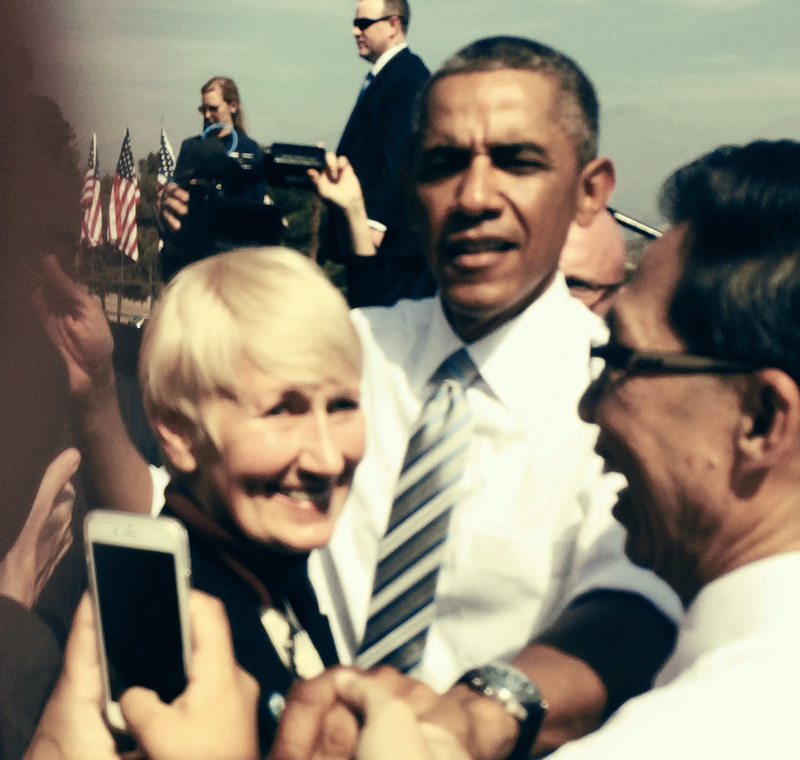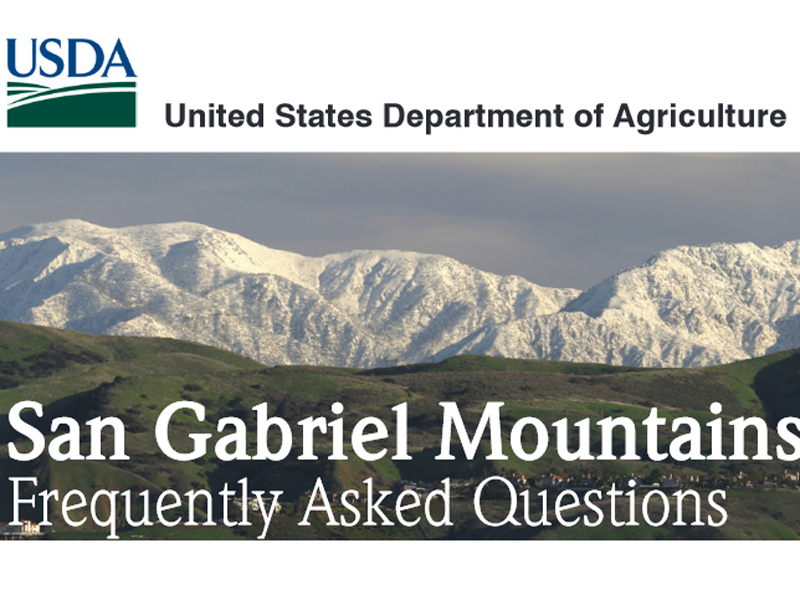|
|

|
October 10, 2014: President Barack Obama came to Bonelli Park in San Dimas on Friday to designate the San Gabriel Mountains National Monument. The 346,177-acre monument includes 14,700 acres of the 25th Congressional District east of the 14 Freeway in Canyon County/Soledad Canyon and the region immediately south of Acton. In July, the Santa Clarita City Council unanimously endorsed a more expansive legislative proposal, H.R. 4858, which would have established the Santa Monica Mountains National Recreation Area ... in particular because it "recognize(d) the importance of the Upper Santa Clara River area," according to a city staff report, "as the last unchannelized riparian and wildlife corridor in the region, providing primary remaining east-west biological connection between the San Gabriel Mountains and the Pacific Ocean." Obama, whose executive action effectively preempted the legislation, credited its authors for having "driven this effort," which accomplishes many of the same goals. One difference is that H.R. 4858 would have transfered management of the region to the National Park Service; Obama's action keeps it under the Forest Service.
Remarks by the President at Designation of the San Gabriel Mountains as a National Monument Frank G. Bonelli Regional Park, San Dimas, California 1:24 P.M. PDT THE PRESIDENT: Hello, everybody! Have a seat. Have a seat. Well, thank you, Secretary Vilsack, for that introduction — more importantly, all the work that you do every single day to make sure that rural America and all our natural resources and conservation strategies are working the way they're supposed to. I also want to acknowledge San Dimas Mayor Curt Morris. Where's Curt? There he is right there. Thank you, sir, for your hospitality. Thanks to all the members of Congress who are here, who make such an important contribution to our conservation agenda every single day. And I want to thank all of you who are blessed to live in the shadow of these extraordinary mountains for the work that you are making and have made so that this day could be a reality. And 150 years ago, President Lincoln signed a law that forever changed the way we conserve our natural heritage. It might have seemed like an odd thing to do at the time. Civil war raged between North and South; the fate of our union hung in the balance. Lincoln himself had never even been to California. For a good part of his life, his home state of Illinois was considered the West. But descriptions and drawings, and even some early photographs of the Yosemite Valley, had made their way back East — the cathedral peaks, the waterfalls, the giant sequoias. So too had stories about encroaching development that threatened the area. So President Lincoln decided to help protect a place he had never visited — for a nation he might not be able to save and for a future he would never live to see. And that place is at the heart of what now is Yosemite National Park. So it's fitting that we meet here in California, because this was the state that inspired Lincoln's actions, and made possible all that followed, including this moment. Today, I'm using my executive authority to designate the San Gabriel Mountains as a national monument. Now, this could not have happened without the leadership of Representatives Grace Napolitano, whose district we're in, Judy Chu, Adam Schiff, the local officials and community leaders, the faith leaders, the youth groups, so many others who have driven this effort. I can see why you've been so committed to this cause. This incredible 346,000 acres of rugged slopes and remote canyons are home to an extraordinary diversity of wildlife. The rare Arroyo Chub swims through the cool streams, while the California condor soars above the vistas. You can hike through the chaparral, amid wild lilacs and mountain mahogany. Maybe you can swat away some rare native insects. But it's not just the natural beauty of the San Gabriels that makes it invaluable. Within these hills lies millennia of history, including the ancient rock art of Native peoples — the first Americans. And just as this region teaches us about our past, it has always offered us a window into the future. It was here at the Mount Wilson Observatory that Edwin P. Hubble showed the universe to be ever-expanding, and it's where astronomers still explore the mysteries of space. I can think of no better way to honor our past and protect our future than by preserving the San Gabriel Mountains. Not only because of its richness of history and culture and science; not only because of its scenic beauty that attracts over 3 million visitors every year — more than icons like Mount Rushmore and the Grand Tetons; but because the story of the San Gabriel Mountains is, in many ways, the story of America. It's the story of communities exploring the great west — of Native Americans and Spanish missionaries, of colonialists and rancheros, of merchants and landowners. It's the story of prospectors in search of gold; of settlers in search of a new life. It's a story that continues today, with one of our nation's most vibrant, diverse communities in the backyard of the second-biggest city in the country. Over 15 million people live within 90 minutes of the San Gabriel Mountains. These mountains provide residents with roughly 30 percent of their water and 70 percent of their open space. This whole area is a huge boost to the local economy. As President, I've now preserved more than 3 million acres of public lands for future generations. And I'm not finished. As I said in my State of the Union, we are looking at additional opportunities to preserve federal lands and waters, and I'll continue to do so, especially where communities are speaking up. And that's what makes this particular designation so important. We heard from the community that for a lot of urban families this is their only big, outdoor space. And too many children in L.A. County, especially children of color, don't have access to parks where they can run free and breathe fresh air, experience nature, and learn about their own environment. And that was Brenda Kyle's experience. Growing up in the foothills of the San Gabriel Mountains, she could see those peaks from her backyard. As an adult, she spotted them from downtown L.A., on TV above the Rose Parade, and from the stands at Dodgers Stadium. Sorry about the playoffs, by the way. But when Brenda drove, she'd use these mountains as her North Star — knowing that if she followed them, they'd take her home. But she never once explored them. Today, she's a docent at Eaton Canyon and devotes her time to taking Latino youth to discover the wilderness of the San Gabriels, many for the first time in their lives. She takes her own nephews up there to play in the river and stand in the waterfall, and spot new birds, and learn from the incredible natural classroom that surrounds them. And she hopes that one day they'll take their own families to the San Gabriel Mountains and say, "We're thankful our forest is a national monument. We always knew it was awesome." And for Brenda, for the entire community, this is an issue of social justice. Because it's not enough to have this awesome natural wonder within your sight — you have to be able to access it. Right now, campgrounds are crowded, parking lots are tight, and there haven't been enough resources to manage and maintain this area the way it deserves. So designating the San Gabriel Mountains as a national monument is just the first step towards a broader effort to change that. It's going to enable the Forest Service and local communities and leading philanthropists to work together to increase access and outdoor opportunities for all. And we'll keep working with you to make sure that everybody in this diverse community — no matter where they come from or what language they speak — can enjoy all that this monument has to offer. The notion of a national monument is interesting because it reminds us that America belongs to all of us — not just some of us. My commitment to conservation isn't about locking away our natural treasures; it's about working with communities to open up our glorious heritage to everybody — young and old, black, white, Latino, Asian, Native American — to make sure everybody can experience these incredible gifts. The San Gabriel Mountains National Monument will join a vast landscape of protected national treasures — a wilderness that the writer Wallace Stegner once called, "a part of the geography of hope." We are blessed to have the most beautiful landscapes in the world. We have a responsibility to be good stewards of those landscapes for future generations. So let me once again say thank you to all of you who made this happen, and for your continued commitment to preserving our magnificent natural inheritance, and for ensuring that this "geography of hope" remains the birthright of all Americans — not only for today, but for generations to come. Thank you, everybody. Now I'm going to sign this proclamation. (The proclamation is signed.) END 1:35 P.M. PDT
|
List: Ranger Stations & Fire Stations
Brief History of Angeles Natl Forest
Map: San Gabriel Mtns Nat Monument 2014
SCV Area Map 2014
FAQ: San Gabriel Mtns Nat Monument 2014
Video: Monument Signing Ceremony 2014
New Signage 2/18/2015
The Stories of Monarch and Pinto
Mining & Ranching in Soledad Canyon & Antelope Valley (Earle 2003)
Black Cat Mine
1967: Forest Turns 75
(Newhall Ranger Station 1923)
Newhall Ranger Station 1950s
District Map 1953
Cultural Resources: Verizon Facility, Mt. Baldy
Film: The Big Bus 1976
|
The site owner makes no assertions as to ownership of any original copyrights to digitized images. However, these images are intended for Personal or Research use only. Any other kind of use, including but not limited to commercial or scholarly publication in any medium or format, public exhibition, or use online or in a web site, may be subject to additional restrictions including but not limited to the copyrights held by parties other than the site owner. USERS ARE SOLELY RESPONSIBLE for determining the existence of such rights and for obtaining any permissions and/or paying associated fees necessary for the proposed use.















